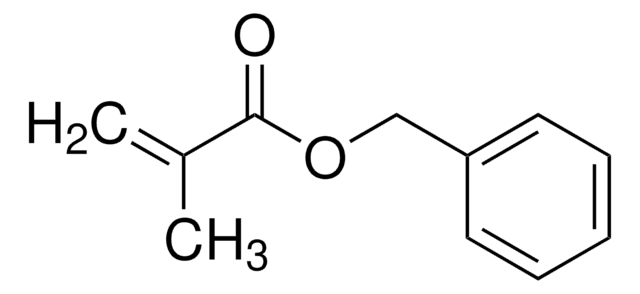408964
Cyclohexyl methacrylate
≥97%, contains ~60 ppm monomethyl ether hydroquinone as inhibitor
Synonim(y):
Methacrylic acid cyclohexyl ester
About This Item
Polecane produkty
Próba
≥97%
Postać
liquid
zawiera
~60 ppm monomethyl ether hydroquinone as inhibitor
współczynnik refrakcji
n20/D 1.458 (lit.)
tw
68-70 °C/4 mmHg (lit.)
gęstość
0.964 g/mL at 25 °C (lit.)
ciąg SMILES
CC(=C)C(=O)OC1CCCCC1
InChI
1S/C10H16O2/c1-8(2)10(11)12-9-6-4-3-5-7-9/h9H,1,3-7H2,2H3
Klucz InChI
OIWOHHBRDFKZNC-UHFFFAOYSA-N
Szukasz podobnych produktów? Odwiedź Przewodnik dotyczący porównywania produktów
Powiązane kategorie
Opis ogólny
Zastosowanie
- As a monomer to prepare poly(cyclohexyl methacrylate) (PCHMA) thin films for high-performance luminescent solar concentrators(LSCs). These LSCs can be used to fabricate high-quantum yield photovoltaic solar cells.
- As a comonomer to prepare photo-patternable quantum dot-acrylate resins for fabricating light-emitting diodes with high color transparency.
- As a monomer to synthesizesuperhydrophobic silica nanoparticle surfaces for various applications such as anti-corrosionsurfaces, drag reduction, and energy conservation.
Hasło ostrzegawcze
Warning
Zwroty wskazujące rodzaj zagrożenia
Zwroty wskazujące środki ostrożności
Klasyfikacja zagrożeń
Eye Irrit. 2 - Skin Irrit. 2 - Skin Sens. 1 - STOT SE 3
Organy docelowe
Respiratory system
Kod klasy składowania
10 - Combustible liquids
Klasa zagrożenia wodnego (WGK)
WGK 1
Temperatura zapłonu (°F)
181.4 °F
Temperatura zapłonu (°C)
83 °C
Środki ochrony indywidualnej
Eyeshields, Gloves, type ABEK (EN14387) respirator filter
Certyfikaty analizy (CoA)
Poszukaj Certyfikaty analizy (CoA), wpisując numer partii/serii produktów. Numery serii i partii można znaleźć na etykiecie produktu po słowach „seria” lub „partia”.
Masz już ten produkt?
Dokumenty związane z niedawno zakupionymi produktami zostały zamieszczone w Bibliotece dokumentów.
Klienci oglądali również te produkty
Nasz zespół naukowców ma doświadczenie we wszystkich obszarach badań, w tym w naukach przyrodniczych, materiałoznawstwie, syntezie chemicznej, chromatografii, analityce i wielu innych dziedzinach.
Skontaktuj się z zespołem ds. pomocy technicznej










